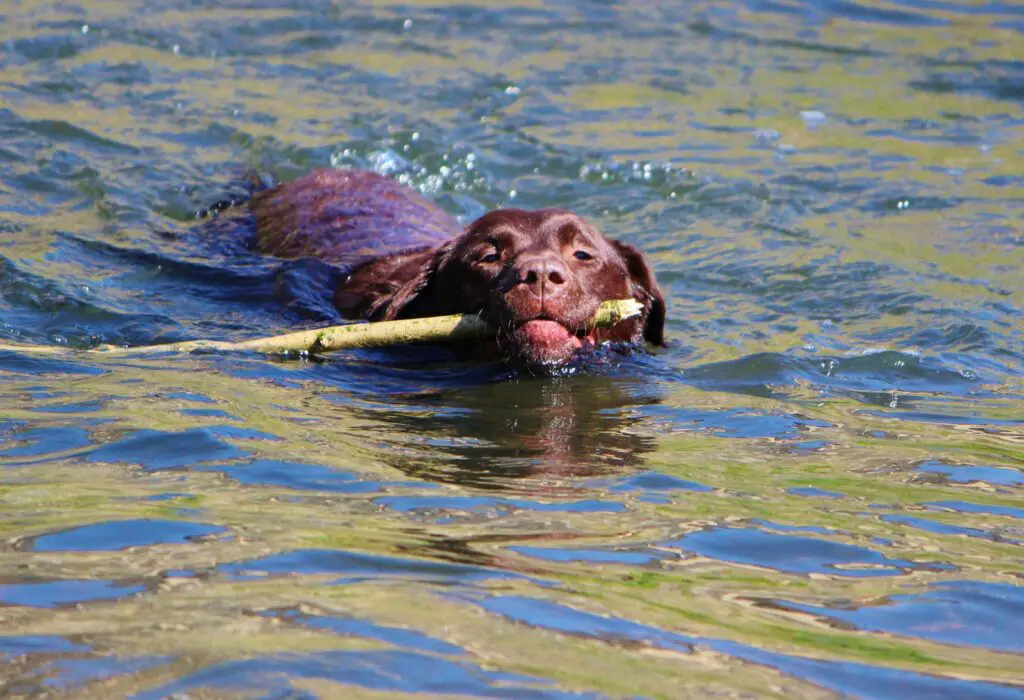Like most other dogs, Labradors start their lives (as newborn puppies) with blue eyes.
But as time goes by, the Labradors seem to lose their blue eye color. Thus, in a newborn chocolate lab blue eyes will be present.
Are the chocolate lab blue eyes permanent? Do some Labrador dogs retain their blue eye color into adulthood? Is it possible to find purebred Labradors with blue eyes? Those are the issues we will be exploring in this article.
All Labrador eyes are blue at birth, by the age of 12 weeks, the permanent eye color settles in. That permanent eye color could be brown or hazel. Sometimes, there can be a delay in the process of permanent eye color acquisition in Labradors. In some cases, it can take up to 16 weeks. But eventually the color does change from blue to either brown or hazel. If blue eye color for dogs doesn’t change, then the dog may have Albinism.

What Color Eyes Do Labradors Have?
There are two main eye colors seen in purebred Labradors: brown and hazel. At birth, the Labradors have blue eye color. But that eventually disappears, with its place being taken by either brown or hazel.
The specific eye color will usually depend on the lab’s overall body color. Labs come in three main colors, namely chocolate, yellow and black. In a chocolate lab blue eyes present at birth eventually turn brown or hazel. In yellow and black labs, the blue eyes eventually turn brown.
Thus, as a general rule, purebred chocolate lab eyes are usually either brown or hazel. Yellow lab eyes are usually brown. And black lab eyes are usually brown as well. It is only the chocolate Labrador that has two possible eye colors: brown or hazel. Thus for a chocolate lab blue eyes present at birth could either turn brown or hazel. For black and yellow labs, the permanent eye color is always brown.
Why Does My Lab Have Blue Eyes?
Labrador eyes should either be brown or hazel in color. Against that background, if your Labrador Retriever eyes are blues, you may be wondering why that is the case. One possible reason is that the lab is still young and therefore yet to acquire the permanent eye color. This applies if your lab is less than 16 weeks old. Thus, for instance, in a chocolate lab blue eyes can last up to 16 weeks. But usually, the eye color change has taken place by week 10 to 12.
Another possible reason why your lab eye color is blue could be because he is not a purebred Labrador. This would be the case if the Labrador is older than 16 weeks (meaning that the blue eyes are permanent). Purebred Labradors can only have brown or hazel colors. If your Labrador has permanent blue eyes, it would mean that he is probably a mix: not a purebred Labrador. Thus, for instance, in a mix (non purebred) chocolate lab blue eyes could be permanent.
It really doesn’t matter whether the Labrador is chocolate, black or yellow. In a chocolate lab blue eyes should turn brown (or hazel) by 16 weeks. The same applies for a black lab with blue eyes: they should turn brown by week 16. That would still be the case for a yellow lab with blue eyes. They are supposed to have turned brown by week 16. If they haven’t, he is probably not a purebred Labrador.
So we can safely say that any Labrador with blue eyes that are permanent (beyond 16 weeks) is not purebred.
Can Lab Puppies Have Blue Eyes?
Yes, lab puppies (like all other dog puppies) can have blue eyes. In fact, they should have blue eyes. If you encounter a blue eyed Labrador puppy, he is entirely normal. But the blue eyes do eventually turn brown or hazel as time progresses. For instance, in a chocolate lab blue eyes are expected to have turned brown or hazel by (latest) week 16.
Similarly, you are unlikely to find a purebred yellow or black Labrador with blue eyes past week 16. Their eyes should eventually turn either brown or hazel color.
| Labrador Dog Color | Expected Eye Color (if purebred) |
| Chocolate | Brown or Hazel |
| Black | Brown |
| Yellow | Brown |
Can a Chocolate Lab Have Blue Eyes?
For a newborn chocolate lab blue eyes are normal. But for an older (beyond 16 weeks) chocolate lab blue eyes are not normal. So, can a chocolate lab have blue eyes? Yes, but only when it is a newborn puppy below 16 weeks. Beyond that the chocolate lab’s eyes are expected to turn either brown or hazel.
The chocolate lab eye color change actually tends to happen faster: typically between the 8th and 12th week. 16 weeks is only given as the latest time by which it should have happened.
Do Chocolate Lab Puppies Eyes Stay Blue?
No. Chocolate lab puppies eyes don’t stay blue. They eventually turn to either brown or hazel color. This should happen between week 10 and week 12 of the puppies’ lives. Even when the eye color changing process delays, it shouldn’t go past 16 weeks.
So what color eyes do chocolate labs have at adulthood? The answer is either brown or hazel.
In any chocolate Labrador blue eyes are not permanent: they eventually become brown or hazel. Any chocolate lab with blue eyes that are permanent is probably not a ‘real’ Labrador: but probably a mix. In an adult chocolate lab blue eyes are indicative of being a ‘mix’. That is similar to how, in an adult chocolate lab green eyes would suggest that the dog is a mix.
Also take note that the hazel eyes in a chocolate Labrador can be mistaken for ‘yellow’. In that sense, chocolate lab yellow eyes wouldn’t be viewed as being out of ordinary.
Can Full Blooded Labs Have Blue Eyes?
Full blooded Labrador dogs can only have blue eyes when they are newborn (below 16 weeks). But full blooded labs can’t have permanent blue eyes. That is with the exception of the so-called silver Labrador dogs: which sometimes have permanent blue eyes. But then again, many experts seem to be of the view that the said ‘silver’ Labrador dogs are not purebred.
Do Yellow Labs Have Blue Eyes?
In other words: can yellow labs have blue eyes that are permanent? The answer is ‘no’. Permanent eye color for yellow labs is usually brown. This is to say that in yellow labs blue eyes are not permanent.
They quickly turn brown – usually within the first 8 to 12 weeks of the puppies’ lives. In any event, yellow lab eye color is likely to have changed from blue to brown by latest week 16.

Do All Silver Labs Have Blue Eyes?
Or, to put it differently, do silver labs keep their blue eyes into adulthood? The answer is ‘no’. Whereas some (rather few) silver labs have blue eyes that are permanent, most don’t keep their blue eyes. Most silver labs will eventually have their eyes turn brown.
Thus, if you encounter a newborn silver grey lab with blue eyes puppy stage, chances are that they will change. Chances are that by the 10th to 12th week, the eyes would have turned brown. Latest by the 16th week. Normally, gray lab blue eyes soon turn brown.
Do White Labs Have Blue Eyes?
White Labrador dogs only have blue eyes when they are puppies (below 16 weeks). Beyond that, the color of their eyes turns brown. If you encounter any adult white labs with blue eyes, chances are that they are not purebred. Purebred Labrador eye color can only be brown or hazel. The blue color is only seen at the newborn puppy stage. Just as chocolate lab blue eyes eventually turn brown or hazel, so do white labs’ blue eyes turn brown.
So the whole situation is similar to where in a yellow lab blue eyes would only be temporary. The Labrador dog shouldn’t be having blue eyes well into adulthood. The blue eyes shouldn’t go past (latest) the 16th week of its life – if it is purebred.
Can Black Labs Have Blue Eyes?
The simple answer is ‘no’. Purebred adult black labs usually have brown eyes. If you encounter a black lab with blue eyes, it could be one of two things. Firstly, the black lab with blue eyes could be a puppy. It could be a puppy whose eyes are yet to acquire the expected brown color. Alternatively, the black lab with blue eyes could be a mix (that is, non purebred Labrador).
To put it differently, purebred black labs can only have blue labs if they are newborn puppies. That is, if they are less than 16 weeks old. If you find adult black labs with blue eyes, they are probably not purebred. The same applies if you find a black lab with green eyes: it is probably not purebred. For purebred black labs, the expected eye color is brown. That is similar to how in a chocolate lab blue eyes would be an indication of genetic ‘impurity’.
How Do You Tell If a Puppy’s Eyes Will Stay Blue?
Simple. If the puppy’s eyes maintain the blue color past a certain period of time, chances are that they are permanent. For instance, in Labrador dogs, that is 16 weeks (latest). It is the age by which permanent eye color is supposed to have been attained.
Thus, lab puppy blue eyes are supposed to have turned brown or hazel within weeks. The latest should be by 16 weeks of age. If they haven’t they are probably permanent. The puppy will stay with blue dogs.
Blue Eyed Labrador Retriever Temperament
If you encounter a blue eyed Labrador Retriever, chances are that he is a mix (not a pure breed). Even then, the dog is likely to have some aspects of the stereotypical Labrador Retriever temperament. So he is likely to be an easygoing, friendly and playful dog.
Blue Eyed Labrador Retriever Shedding
Purebred Labrador Retriever dogs tend to shed at least on biannual basis. But if you find a blue eyed Labrador Retriever, chances are that he is a mix and not purebred. Thus his shedding tendencies will depend on what else (besides Labrador Retriever) he is a mix of. Most blue eyed Labrador Retriever dogs do tend to shed regularly throughout the year.
Blue Eyed Labrador Retriever Breeders
Blue eyed Labrador Retriever breeders fall into two categories. The first category is that of those who are frank about the dogs they breed. They are frank enough to say that their blue eyed dogs are not purebred Labrador Retrievers.
The second category has those who try to pass off the blue eyed Labrador Retriever dogs for purebred labs. Some of course do this with pure intentions. They do so with justification from the controversial argument that the blue eyed ‘silver’ labs are purebred.
If you are looking for a blue eyed chocolate lab for sale, there are breeders who can assist you. Some can even sell you a chocolate lab with green eyes or a yellow lab with green eyes. The idea of there being labs with green eyes can admittedly sound incredulous. But if you are not too strict about breed purity, you can actually get them.
In all such cases, there is one thing you need to know. You need to know that these Labradors with eye colors other than brown and hazel are probably not purebred. Thus, for instance, in any chocolate lab blue eyes would be indicative of the fact that it is not purebred.
Blue Eyed Labrador Retriever Price
Because most blue eyed Labrador Retriever dogs are not purebred, they tend to go for lower prices than pure breeds. But that is not universal. Don’t, for instance, assume that in any chocolate lab blue eyes will automatically translate into a lower price. There are some breeders who will try to brand the blue eyed labs as ‘premium’ dogs. Such can end up selling the Labrador Retriever mix dogs for higher prices than purebred Labrador Retriever dogs!
It is also important to understand that a dog that is not purebred isn’t always inferior to a purebred dog. To put it differently, in any given lab puppy blue eyes are not a sign of inferiority. That applies even if the said lab puppy blue eyes seem to be permanent. Thus, for instance, in a chocolate lab blue eyes are not necessarily indicative of inferiority to brown or hazel eyes.
If you are shopping for a blue eyed Labrador Retriever, you have to enquire about the age. It could be that the blue eye color you are seeing is not permanent. Especially if the dog is less than 16 weeks old.
Thus, you could buy a chocolate Labrador with blue eyes only for its eyes’ color to change within weeks. So it would be important to find out if the chocolate lab eye color (blue) is permanent or not. And if it is permanent, then you need to know that it is almost certainly not purebred.
That also applies when shopping for a blue eyed black lab puppy. Find out if the blue color you are seeing in the eyes is permanent. Understand that it could change to brown (as it should). Similarly, for a newborn puppy chocolate lab blue eyes may be temporary: and could turn brown or hazel.
Blue Eyed Labrador Retriever Trainability
Because most blue eyed Labrador Retriever dogs are not purebred, they may not be as trainable as purebred labs. But because of the Labrador blood in them, they will still tend to have high intelligence. That should translate into a good degree of trainability.
Blue Eyed Labrador Retriever Sociability
Purebred Labrador Retriever dogs (whose permanent eye colors are either brown or hazel) tend to be very sociable. On the other hand, the blue eyed labs (which are obviously not purebred) may not be as sociable. But chances are that they would have a decent degree of sociability. This would be on account of the Labrador Retriever genes in them.

Final Verdict – Chocolate Lab Blue Eyes
Most of the Labradors with blue eyes are not purebred. They are mixes. But they do tend to have many of the traits we associate with purebred Labrador Retriever dogs. Thus if you want a Labrador with blue eyes, you can go ahead and order for it from a breeder.
Just be sure to ask what else it is a ‘mix’ of (besides Labrador). Ultimately, with proper training, blue eyed Labrador dogs should be capable of performing nearly as well as purebred labs.

Welcome to Learn About Pet. My name is Rajkumar Ravichandran and I love all pets, travel, and amazing food. I write about my passion and personal experience caring for multiple pets in this blog! ❤️
Post Disclaimer
DISCLAIMER: THIS BLOG OR WEBSITE, "Learn About Pet", DOES NOT PROVIDE YOU WITH MEDICAL ADVICE AND IS NOT A SUBSTITUTE FOR MEDICAL ADVICE. ALWAYS GET IN TOUCH WITH YOUR PERSONAL VETERINARIAN AND USE INFORMATION HERE AS GENERAL ADVICE.
The information, including but not limited to, text, graphics, images and other material contained on this website are for informational purposes only. No material on this site is intended to be a substitute for professional veterinary advice, food recommendation, diagnosis, or treatment. Always seek the advice of your veterinarian or other qualified health care provider with any questions you may have regarding a medical condition or for pet food related questions.







